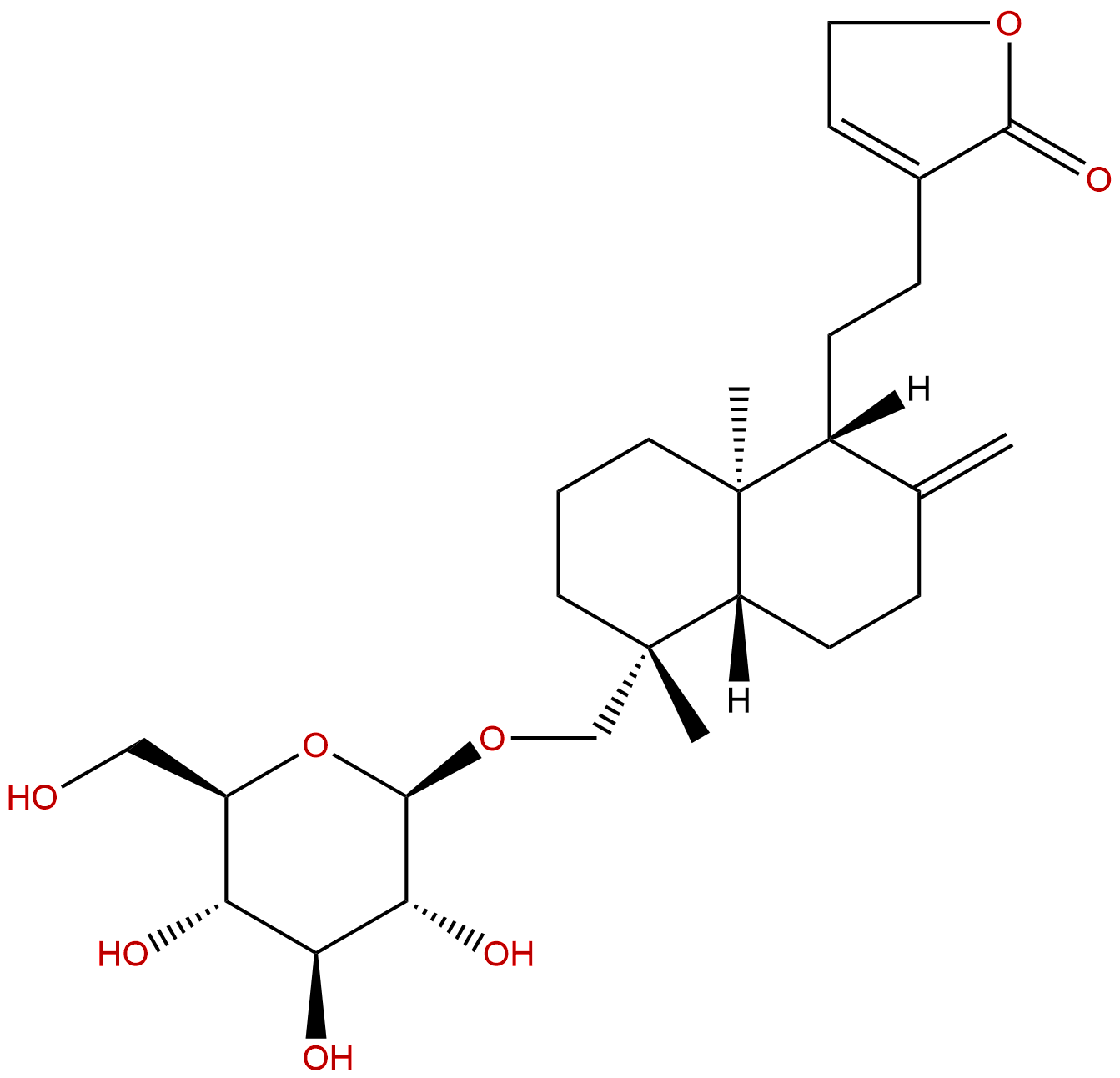
NeoandrographolideCAS No.:27215-14-1
|
||||||||||
 |
|
|
||||||||

| Catalogue No.: | BP0988 |
| Formula: | C26H40O8 |
| Mol Weight: | 480.598 |
Product name: Neoandrographolide
Synonym name:
Catalogue No.: BP0988
Cas No.: 27215-14-1
Formula: C26H40O8
Mol Weight: 480.598
Botanical Source: Andrographis Herba
Physical Description:
Type of Compound: Diterpenoids
Purity: 95%~99%
Analysis Method: HPLC-DAD or/and HPLC-ELSD
Identification Method: Mass, NMR
Packing: Brown vial or HDPE plastic bottle
Storage: Store in a well closed container, protected from air and light. Put into refrigerate or freeze for long term storage.
Whenever possible, you should prepare and use solutions on the same day. However, if you need to make up stock solutions in advance, we recommend that you store the solution as aliquots in tightly sealed vials at -20℃. Generally, these will be useable for up to two weeks.
The product could be supplied from milligrams to grams
Inquire for bulk scale.
Description:
Neoandrographolide has antiradical, anti-inflammatory,and hypolipidemic effects, it protects the cardiovascular without significant liver damage. Neoandrographolide as chemosensitizer in S-Jurkat and X chromosome-linked inhibitor of apoptosis protein (XIAP)-overexpressing Jurkat cells, a model for chemoresistance.Neoandrographolide inhibits iNOS and COX-2 expression through inhibiting p38 MAPKs activation.
References:
Planta Med. 2010 Oct;76(15):1698-700.Neoandrographolide from Andrographis paniculata as a potential natural chemosensitizer.
Extracts of the traditional medicinal herb Andrographis paniculata and its main constituents are described in the literature as showing anticancer activity. The aim of this study was to isolate the main constituents of a commercially available phytotherapeutic preparation of A. paniculata and to determine their chemosensitizing potential in a leukemia cell line.
METHODS AND RESULTS:
Chromatographic separation steps resulted in the isolation of the diterpenes andrographolide (1) and 14-deoxy-11,12-didehydroandrographolide (3) and the diterpene glucoside Neoandrographolide (2). The combination of these constituents with suboptimal concentrations of etoposide revealed compound 2 as chemosensitizer in S-Jurkat and X chromosome-linked inhibitor of apoptosis protein (XIAP)-overexpressing Jurkat cells, a model for chemoresistance.
Phytother Res. 2013 Apr;27(4):618-23.
Hypolipidemic effects of andrographolide and neoandrographolide in mice and rats.
Andrographolide (AND) and Neoandrographolide (NEO) are the diterpenoids from the Andrographis paniculata (Acanthaceae). It is reported the diterpenoids exhibit a wide spectrum of biological activities.
METHODS AND RESULTS:
The aim of this study was to investigate the hypolipidemic effect of AND and NEO in hyperlipidemic mice induced by 75% yolk emulsion and in hyperlipidemic rats induced by high fat emulsion, respectively. The results showed that the levels of triglyceride, total cholesterol (TC) and low-density lipoprotein cholesterol were reduced by AND and NEO in a dose-dependent tendency in mice. Compared with the model group, the plasma TC levels of experimental groups with AND and NEO at 100 mg/kg dosage decreased by 23.9 and 20.2% in rats, respectively (P < 0.05). It was also found that the plasma aspartate transaminase and alanine transaminase levels were significantly decreased by feeding with AND and NEO in rats, compared with positive group (simvastatin) (P < 0.01). Otherwise, AND and NEO could protect the cardiovascular due to down-regulation of iNOS expression and up-regulation of eNOS expression.
CONCLUSIONS:
In conclusion, AND and NEO have potent hypolipidemic effects and protect the cardiovascular without significant liver damage.
Am J Chin Med. 2007;35(2):317-28.
In vivo and in vitro anti-inflammatory activities of neoandrographolide.
Neoandrographolide, one of the principal diterpene lactones, isolated from a medicinal herb Andrographis paniculata Nees, was tested in vivo and in vitro for its anti-inflammatory activities and mechanism.
METHODS AND RESULTS:
Oral administration of Neoandrographolide (150 mg/kg) significantly suppressed ear edema induced by dimethyl benzene in mice. Oral administration of Neoandrographolide (100-150 mg/kg) also reduced the increase in vascular permeability induced by acetic acid in mice. In vitro studies were performed using the macrophage cell line RAW264.7 to study the effect of Neoandrographolide on suppressing phorbol-12-myristate-13-acetate (PMA)-stimulated respiratory bursts and lipopolysaccharide (LPS)-induced production of nitric oxide (NO) and tumor necrosis factor-alpha (TNF-alpha). Respiratory bursts were quantified by chemiluminescence (CL) measurements. Results showed that Neoandrographolide suppressed PMA-stimulated respiratory bursts dose-dependently from 30 muM to 150 muM. Neoandrographolide also inhibited NO and TNF-alpha production in LPS-induced macrophages, contributing to the anti-inflammatory activity of A. paniculata.
CONCLUSIONS:
These results indicate that Neoandrographolide possesses significant anti-inflammatory effects, which implies that it would be one of the major contributing components to participate in the anti-inflammatory effect of A. paniculata. and a potential candidate for further clinical trial.
HPLC of Neoandrographolide
